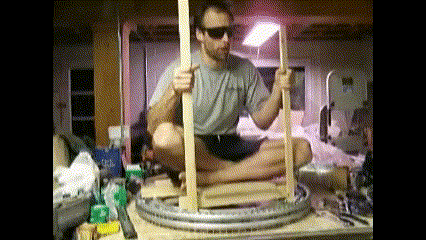An American built a huge combat robot in the forest

Have you ever wondered how difficult it is to turn something you have in mind into a real product? For example, would you be surprised to see someone controlling a huge iron spider robot that can turn on the spot and obediently walk in the direction the pilot points it?
To realize his idea, this persistent designer overcame many obstacles: he came up with the mechanism himself, mastered the skills of aluminum welding, laser cutting, 3D printing, created a small prototype and built one. His project stands out even among the most interesting DIY devices you've read about.
Sit back and take a break from the hustle and bustle while you read this rather lengthy article. Scrolling through it, you will learn about a wonderful inventor and his resourcefulness, unstoppable vital energy and practical advice to help make your dreams come true, and someone may be encouraged to talk about their own project on this site.
First steps
Back in 2007, an inventor from America decided to bring to life a long-standing idea: to build a huge walker that you could ride on and from which you could shoot in different directions at enemies.
Even earlier, in the early 2000s, an American named Jaimie Mantzel invented propulsion mechanisms for small animal models. One by one, prototypes emerged from under his soldering iron, still made from wire and other simple materials. Their number gradually grew. During the testing process, one after another, they walked briskly around his apartment.
When Jamie already had several ready-made travel schemes in his luggage, the guy decided to finalize one of them. The choice fell on the spider robot. The video shows the first prototype of a robot in a body printed on one of the first, not yet home, 3D printers. The model could walk perfectly on six legs, turn and step over uneven surfaces.
The idea was to make the same one, but of such a size that it would be able to carry a person. The body of the machine was planned to be made of aluminum to lighten the structure.

Plan, start of construction and first successes
Since such a project could require a lot of financial investment, the master decided to use as many available materials as possible during construction. His father had a small workshop, and nearby there was a landfill where some blanks for parts could be found.
As you can see, the driver's cabin was supposed to be located at the top, in the “head” of the spider, from where he was supposed to control the tank using levers.

Jamie prepared thoroughly for the start of construction. First, the inventor showed the entire set of materials that he had collected for construction. Most of them, as it would be easy to guess, turned out to be aluminum pipes found in a landfill. The parts had to be welded with something, and the first monetary outlay was a welding machine, on which I had to learn how to weld aluminum. It cost, not much – not less, $1000.
Jamie started by bending aluminum pipes himself and connecting them into two rings. I put it on rollers, and it turned out to be a movable hinge for rotating the tower. The turret rotation is roughly the same as that of real tanks.
Then it's time for the next details. The inventor carefully filmed the entire construction process, and showed how he processed the metal, how he cut his fingers countless times and got bruises on different limbs. In the end, he showed that he was able to assemble a joint of his own design, which was key to walking.

One of the main properties of such a device is the very high number of degrees of freedom of some parts. Their mobility had to be achieved using an incredible number of bearings, which also cost a lot of money. When they arrived, the master was very happy that they suited him.
The designer began building an enlarged model of his invention just two years after the creation of YouTube itself, and the creation of the machine took six years. Since the designer’s camera of that time, although it was digital, filmed in 240p quality, for illustrations in the article, images from it had to be run through a neural network.
The structure of walkers and the uniqueness of new designs
What helped you decide to build such a complex device? Let's take a close look at the movement scheme invented by our inventor.
Jamie, during his work, collected not one, but several inventions. The mechanisms he invented for the movement of animal models included a dog, two types of spiders, a gecko, a turtle, caterpillar and even a fish. I couldn’t find a video with the fish, but there is a photo of it somewhere in the depths of it site.
The videos were shot, it seems, with an even older, analog camera. These are the ones who recorded videos on video cassettes with magnetic tape.
At that time, Sony was selling the robotic dog Aibo, and amateurs were creating six-legged robots with servo motors themselves. Let's calculate how complex these models are. Sony's robotic dog Aibo uses 22 servos. Its first models had 18 servomotors. Spider robots like this also have about 18 motors.

The model mover Jamie has an undeniable advantage over others. How many motors do you think are needed to move this spider model of his? As they say, stop the video at this point and write your guess in the comments.
So how much? You guessed wrong. Thanks to the new design invented by this inventor, it uses only 2 motors.
In general, you can get by with just one, it moves the car forward and backward. The second is located in the rotating tower and controls only the direction of its movement. Most likely, his other animal models also have only 1 or 2 motors, not “servos”. Most likely, the dog in the video above also only has 2 motors, but despite this, in the video above, look how natural his gait and turns look!
Look: for walking machines with many legs, such a simple mechanism has never been used anywhere before.

Walking, using only two motors for movement, became possible with the help of the mechanics and hinge invented by the designer. Thanks to his findings, it turned out to be easier to manufacture than most existing walking devices. What helped him decide to build a large robot was that the design was unlike any previous walker mechanism, and it was the simplicity and uniqueness of the design that made Jamie realize that a full-size copy of the tank would work.
Obstacles and original ways to overcome them
The outlines of a full-size robot began to emerge. The design has already received the main elements of the body, the turret mount, and hinges that allow the legs to move.

And at this time the first obstacle appeared. It was Jamie's girlfriend. Seeing that the house was quickly filling up with iron from the dump, she protested. Her claims were completely justified and, in order not to argue with them, a solution was found that was as original as his whole idea.
Production on a grand scale
It seems that it was simply impossible to build a robot using existing production facilities, and it was necessary to expand. The inventor decided not to be discouraged, but, instead, to attack the problem with even greater strength: to build a second workshop next to the house. He began the construction of the workshop by creating a sawmill. The sawmill also turned out to be of its own design.
It was built from free aluminum profiles and pipes. The investment was another $100: a 2 hp motor. for $80, bearings and a belt for transmitting energy from the motor to the saw mechanism.
Awesomeness, don't need anything more
The girl’s questions were supplemented by the neighbors’ misunderstanding. People are afraid of strange things: when you create something from them whose silhouette resembles something straight out of a cyberpunk anime, they are wary of it.

Have you ever wanted to assemble something yourself? Is there a project on your mind right now that you have been thinking about for a long time and never decided to create? Have you wanted to share the creation process by writing your own article about it, but never got around to it? Have you already started doing something, but then abandoned it, without telling anyone, and therefore no one will ever know about it?
Probably everyone thinks to themselves, why should I waste time, what if it doesn’t work out, and what if no one appreciates my efforts? How will I spend money that no one will reimburse later, energy that I could spend on a walk or going to a cafe? Our hero Jamie faced the same problems.
When neighbors passed by his house, they saw a large and incomprehensible metal structure in the workshop.
“Why?”, “What is he doing” – he was pursued with questions.
At the end of the next video, the guy depicts their reaction after he told them that he was building a huge robot.
What could motivate you to spend so much time and effort on a new project that no one understands?
When Jamie, like perhaps some of you about his unstarted project, asks the question in this video: “Why am I building it?”, he himself gives the answer there. You need to do something planned because it in itself is simply awesome. No one has done this before! “When you do something that others don’t do, the most important thing is that you need it. The result that you will get at the end, and that others will share with you, cannot be bought, it cannot be obtained without your efforts – it will be awesome, awesomeness!”
Lack of work space
Jamie devoted himself completely to his work; it completely took up his time. However, it was necessary to live on something. It seems that his dad had already asked him to vacate the workshop, and there was a misunderstanding among the neighbors, and he most likely wanted to live separately with his wife and child.
The designer had his own plot of land in the middle of the forest, but it was in another state. Orders for part-time work also turned up there, with which he made a living. However, in the new place, in Vermont, there was neither a house nor a workshop. A couple of years ago, he began building a house there for one person, which was called Dome because it had a round shape. However, I haven’t even had time to complete it yet. Despite this, he decided not to be afraid of insoluble difficulties and moved to an unfinished house in the forest.
First, he brought an old airplane hangar into the forest, which they gave him in exchange for simply removing it from the territory. He made his first workshop in the hangar. In parallel with the robot, he set about completing the construction of the house, living in an unfinished building.
Support of colleagues and your own club
The inventor has many subscribers on his YouTube channel. People got involved in the construction of both the house and the walker. They helped as much as they could: they gave away unnecessary metal parts, tools and building materials.
To further stir up interest in building a robot, Jamie created the “Adventure Club.” He also began selling T-shirts with his project's logo. In a video for the club, he began to tell how to build this or that part, connect it, and showed some unusual solutions at a construction site and during prototyping. Somewhere in the middle of building the robot, Jamie made a solar-powered boat, and entertained his viewers by posting videos of it being built and subsequently riding it.
Now, probably, such a project could have been put up on Kickstarter and marketing models could have been invented to promote the video blog, but then there were no such technologies, and the American had to do everything himself. There was no money to be made on YouTube at that time, and selling T-shirts was some kind of help. The club's logo consists of a crossed wrench and hammer with a smiley face.

Prototyping and trying to promote a new invention
In addition to donations, the inventor began to be actively hired to help in the construction and repair of buildings, and for other construction work. In addition, the master thought about how to make money from his invention.
The designer tried to negotiate with toy companies so that they would produce his spider. Why not? The design is simple to manufacture, it contains a minimum of parts, the number of which cannot be compared with its functionality. A radio channel for radio control, which most often increases the cost of toys, requires not even two, but only one and a half: half of the channel is forward movement, and another one is for turning the tower to the right and left.
Judge for yourself: one and a half radio channels, only two motors, and not a servo: this would not only be an excellent toy, but also one that would be very cheap to produce!
The idea looked like a tasty morsel for a toy manufacturer, so the inventor first went to China. I visited toy exhibitions, talked with potential partners, major manufacturers and sellers.
Embrace of the Dragon Country
Initially, the Chinese’s eyes lit up, but no one was in a hurry to agree to production. The Chinese unanimously complained that they preferred to produce something according to already proven schemes that were profitable. Will there be any profit from the new design? The Chinese did not know this.
It was not possible to come to an agreement with anyone, and the designer left without a sip. It's not hard to guess what happened next. After some time, Jamie was surprised to discover that the market gradually began to be filled with crookedly copied and produced toys with his mechanism.
What a surprise! Having achieved good sales, the Chinese refused to admit that they had stolen the device. The robot cost only five dollars and sold well. Of course, no one was going to share the profit. Attempts to attract lawyers did not help: no one stopped the production and sale of toys.
Is this success or, conversely, failure? On the one hand, the Chinese toy seemed like an obvious fake; it didn’t have such a smooth ride. No one even thought about respecting copyright. On the other hand, despite this, it became clear that the invention was quite successful. It entertains people and is already making a profit.
European companies
The first Chinese pancake turned out to be lumpy, but the master sent it out your video with proposals to European and American companies. This time someone responded. His invited to England for meeting with the management of one of the toy manufacturers. On the way he stops at toy exhibition.
And, this time, we managed to reach an agreement. One of the English companies took over the sales, marketing and production of the new spider robot.
Combat spider robot in mini version
Jamie began making various prototypes for production. To do this, he bought and mastered a plywood laser cutting machine. He placed this machine in the same, but already fairly completed domed house.
At that time, portable 3D printers were starting to appear on sale, and the designer was thinking about switching from laser cutting of plywood to 3D printing.
By that time, his house had grown well and had upper floors. On the third floor, instead of a floor, Jamie, not having the habit, as we know, of wasting little things, put up a trampoline and made a room for entertainment.
At the suggestion of an English company, it was decided to further develop the idea of a combat robot. After several variations of the initial proposals, Jamie came up with the idea of adding knock-down armor to the legs of the tank, and placing a real gun on the turret that shoots plastic cartridges, a Nerf Gun. The company sent samples by regular mail, and they exchanged ideas with the inventor via the Internet.

The kids must have liked it. We managed to achieve a surprisingly smooth gait, which is very far from the Chinese fakes. The force of the shot can be adjusted by changing the tension time of the spring that ejects the projectile.
After going through several successful prototypes, the company chose the most successful one and launched the production of spiders of different colors and with a different set of cartridges: balls, plastic bullets and discs. If you buy several cars, gather a group of people and give them a remote control, it will be quite a battle. You can assemble teams by color, and also attack people who, while shooting back, must use the same cool Nerf Guns to knock down the “armor” from the legs of the fighting spider.
The toy went on sale. The manufacturer came up with a name for the walking six-legged tanks: Combat Creatures Attacknids. At first it could be ordered in England, then in Australia, and after a couple of years, toy stores sold Jamie robots all over the world. Now the profits were already flowing in the right direction. Isn't this the inventor's idea in miniature!
Other obstacles
The project required an increasing amount of effort. To complete the full-size robot, several stages of redesign and strengthening of the structure were required. The designer had to purchase various spare parts again and again, increasing the construction budget. After falling tree The workshop had to restore the hangar and make almost half of the robot from scratch. In the process of all his work, Jamie often injured his hands, to which he dedicated a separate page on his website: https://jamius.com/Injury.html
The inventor stubbornly moved forward and did not succumb to seemingly insurmountable obstacles. He found the strength to continue working, and the first results were already visible in his subsequent videos.

The machine came to life, moving its limbs, making noise with its motor and joints. At the end of the process, when the giant walker was already taking on its calculated shape, it became clear that there were some miscalculations. The structure could walk, but could not support the weight of a person, as planned. In this regard, control had to be done by radio.

The tank also sorely lacked engine power, which someone gave away for free, and there was no other.
Let's take a look at his work. The video shows the final version and a demonstration walk along the forest podium.
The robot does not walk immediately, but quite confidently. It can be seen that, although the power is not enough, the walker is moving.
Because in order to add power and further strengthen the structure, all the work would have to be redone, stretching the budget even further, and in this case it would be easier to assemble a new one. In order not to have to redo anything, Jamie decided that the best solution would be to sell the robot. In the video, he has already taken it to sell. The whole process can be followed in carefully assembled by the master, only then, playlist And Here.
conclusions
It can be calculated that the own funds spent on the construction amounted to a couple of thousand dollars, however, when calculating the cost, one must also take into account the fact that the designer used all the purchased equipment in the construction of sawmills, buildings and other things useful for his life. Subscribers helped reduce costs by donating missing materials and their old tools for free. As it turns out, a community with similar interests can be a big help: several heads are always better than one. You can look at the creation of a large combat robot from a different angle. If you think that Jamie started the whole project to promote his design and stir up interest in the production of the toy, then this idea worked. Whether this is true or not, it’s hard to guess, but what would you say about this?
By now, the inventor was even more immersed in developing his desired life path. He moved to Panama, where he bought his own island, again built a house there, a boat, and an electric car for the children. He grows his own food for his family and lives as his desires dictate. Jamie liked the process of creating a tank, and he promised to build another large robot, taking into account the collected experience in overcoming obstacles. On his island, the designer creates new mechanisms with a non-standard design and continues to improve design of your robot.
In his club, Jamie, by his example, motivates subscribers not to be afraid to challenge routine and not to give up when the first difficulties arise. Would you like to join his Adventure Seekers Club? Would you also like, by describing the process of creating your idea on the Internet, to find followers who will give advice, share ideas, and someday offer help?
How to decide if your idea is worth turning into reality?
“To do this you will have to spend so much effort, money and overcome so many problems!”, “What will people say?”
“I started doing it, got stuck, didn’t know how to move forward, and gave up.”
“Can I do that?”
“Oh, yes, I can make a description of the project and publish it as well, I’m just too lazy!”
“What if it doesn't work out?”
While some of us are wondering whether it’s worth starting to collect what we’ve wanted for a long time, or whether it’s worth writing about it, look at how its inventor had a blast during the construction of this robot. That in the process he gained a lot of subscribers, found solutions to overcome complex problems, and acquired a bunch of useful skills along the way.
Now, upon completion of construction, he has a patent, profits from a toy manufacturer, a computer a gamea sawmill, two self-built houses, several boats and two workshops.
But someone in the clearing, if he did not abandon it in the forest without repair, is walking, obeying the commands of the pilot, his own huge radio-controlled combat iron robot.



